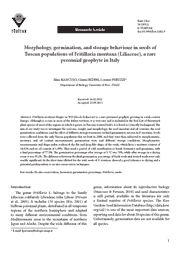NEWS 2012
Morphology, germination, and storage behaviour in seeds of Tuscan populations of Fritillaria montana (Liliaceae), a rare perennial geophyte in Italy
Elisa MANCUSO, Gianni BEDINI, Lorenzo PERUZZI
Turkish Journal of Botany, 36(2): 161-166 (2012)
doi:10.3906/bot-1102-9
Department of Biology, University of Pisa, ITALY
Abstract
Fritillaria montana Hoppe ex W.D.J.Koch (Liliaceae) is a rare perennial geophyte growing in south-eastern Europe. Although it occurs in most of the Italian territory, it is very rare and is included in the Red List of threatened plant species of most of the regions in which it grows; in Tuscany (central Italy), it is listed as Critically Endangered. The aim of our study was to investigate the seed size, weight, and morphology; the seed moisture and oil contents; the seed germination conditions; and the effect of different storage treatments on final germination success in F. montana. Seeds were collected from the only Tuscan population that set fruit in 2008, and they were then subjected to morphometric, moisture, and oil content measurements; germination tests; and different storage conditions. Morphometric measurements and shape index evidenced the fl at and drop-like shape of the seeds, which have a moisture content of 14.62% and an oil content of 1.09%. They need a period of cold stratification to break dormancy and germinate, with a final percentage of 77.5%. The germination percentage aft r storage at 5 °C was 70%, while after storage in a drying room it was 55.2%. The differences between the final germination percentage of fresh seeds and treated seeds were only weakly significant. In the short time allotted for the trial, seeds of F. montana showed a good tolerance to drying and a potential predisposition to ex situ conservation techniques.

